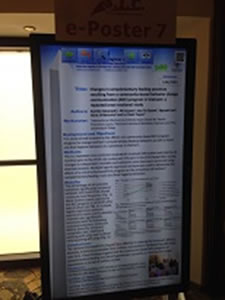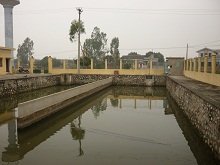|
| CHP(Center for Health
Promotion)
|
Project
SWAN (Safe Water and Nutrition)  |
Safe water and Nutrition project (Project SWAN) works
to improve safe drinking water supply and nutrition/health environments
in developing countries. |
|
|
Activity
up-to-date |
|
Presented during a poster session at the 21st International Congress of Nutrition |
|
|
|
|
|
The outcomes of the “Project to support educational activities for mothers to improve the quality of complementary food in rural Vietnam” were presented during a poster session at the IUNS 21st International Congress of Nutrition (ICN) which was held in Argentina in October 2017. The project was implemented between April 2014 and March 2017 in collaboration between ILSI Japan CHP and National Institute of Nutrition (NIN), Vietnam, with the financial support of AIN (Ajinomoto International Cooperation for Nutrition and Health). The summary of the presentation are as follows: As an undernutrition prevention service of the commune health centers, trained village health workers provided nutrition and food safety information for mothers who have children between 6 and 23 month olds by using several communication channels such as periodical loudspeaker announcements, cooking classes, flip chart communication during household visits. Then, ILSI Japan CHP and NIN evaluated whether mothers became capable to prepare nutritionally balanced and safe complementary food for their children as results of these information, communication and education (IEC) activities. Subsequently, we measured the following 6 outcome indicators at baseline and endline: i) Minimum Dietary Diversity, ii) Minimum Meal Frequency, iii) Minimum Acceptable Diet, iv) Handwashing with soap (children), v) Handwashing with soap (mothers), and vi) food hygiene behaviors of mothers. The study involved 329 mother and child pairs in the baseline survey and 376 pairs in the endline survey. As this is a repeated cross-sectional study where we randomly selected different mother and child pairs between baseline and endline, it allows us to evaluate if the nutrition services have reached entire communities over time. As results, the IEC activities were effective in altering the minimum dietary diversity, minimum acceptable diet, children and mothers’ handwashing with soap over time. In addition, a combination of more than two IEC channels tends to lead nutritionally balanced and safe complementary food preparations. These findings suggest that the IEC activities on complementary feeding and hand hygiene were successful in reaching the target populations in all communities studied.
|
|
|
 |
|
|
|
|
|
|
|
|
|
|
|
|
|
|
|
|
|
For
Newsletter version (PDF), click here
For
the past Newsletters, click here
|
|
|
Achievements
to date |
|
|
|
With an emphasis on rural areas in
developing countries in Asia, where public water works are lacking,
ILSI Japan CHP has since 2001 been investigating the quality
of drinking water and the needs of local residents toward safe
water supplies, food safety and hygienic environment. Through
experiments we have confirmed that the water quality can be
improved to meet the Vietnamese standards for drinking water
by optimizing the operation of existing water treatment facilities.
Based on the preliminary investigations, we conducted the safe
water and nutrition project for 6 years (phase1: 2005-2008 and
phase2: 2010-2013) with a financial support from JICA (Japanese
International Cooperation Agency). In the project, the Water
Management Union composed of a technical group and an IEC group
has been working to generate a synergistic effect to improve
the water supply and health communication system. SWAN1 was
implemented in 3 communes in Hanoi and Nam Dinh Province and
obtained a community level achievements in terms of the improvements
of water supply, food hygiene practice and the reduction of
childhood diarrhea. SWAN2 enabled to enhance cross-sector collaboration
between water and heath sectors and to improve a community-support
system. |
|
Vietnam
Partner: National Institute of Nutrition (NIN) |
|
|
Situation
analysis 1 (2001-2004)
Water quality monitoring was conducted in selected water sources
in the Red River Delta Region for a period of one year (November
2001 - October 2002). Among the total eighteen monitored parameters,
the concentrations of ammonia, arsenic, iron, total coliform,
E.coli were higher than the Vietnamese Drinking Water
Hygienic Standards. Consequently through experiments, we confirmed
that the water quality could be improved to meet the standards
by optimizing operation of existing water treatment facilities.
According to a formative community needs survey using focus
group discussions conducted at the selected sites in May 2004,
community members knew little about the benefits of safe drinking
water, WTF water quality, the role of WTF and water management.
Also we confirmed a strong willingness to participate in activities
for improving and sustaining water quality.

|
|
|
SWAN1: Model development (Nov 2005
- Nov 2008) |
|
|

Based on the preliminary investigations, a proposal titled
"Participatory approach for improving safe water supply, nutrition
and health environment" was proposed and approved by JICA
(Japanese International Cooperation Agency) as a 3-year grassroots
technical assistance project. In November 2005, the project
was started in three communities (Tam Hiep Commune in Hanoi,
Dai Mo Commune in Hanoi, and Quang Trung Commune in Nam Dinh
Province) in the Red River Delta Region northern Vietnam where
2,500 households are supplied from local water treatment facilities.
The Water Management Union composed of a technical group and
an IEC group worked to generate a synergistic effect to improve
the water supply and health management system. Positive outcomes
included decreases in the childhood diarrhoea prevalence and
the underweight prevalence, as well as improvements in the
community members' food hygiene behaviour and child feeding
practices. The quality of water from water treatment facilities
was improved, and the quantity of distributed water was substantially
increased by renovation, training of workers and proper management
of water treatment operations. The improvements have been
sustained by enhancing the capability of local water management
unions. Project SWAN1 was completed with great success in
November 2008.
・Click
here to download the Final Report
・Related publications and presentations (1),
(2), (3),
(4)
|
|
|
Situation analysis 2 (2010-2011)
One of the strategies of the National Target Program of Rural
Water Supply and Sanitation (Center for Rural Water Supply and
Sanitation, Ministry of Agriculture and Rural Development) includes
a cross-sector approach with the Ministry of Health in the area
of hygiene and sanitation improvements through IEC activities.
In parallel, the National Nutrition Strategy 2001-2010 includes
importance of safe drinking water supply, food hygiene and safety,
and environmental sanitation interventions to improve nutritional
status. Vietnam has made remarkable achievements in increasing
access to safe drinking water and improving health and nutritional
status of the population. Among rural populations, access to
"clean water" was an estimated 30% in 2000, 62% in
2005, and increased to 75% in 2010 (5).
However, an estimated 30-40% of population remains at risk from
drinking unhygienic water from "improved drinking water
sources"(6).
By the end of 2007, more than 8,300 piped water supply systems
existed in rural areas of Vietnam covering an estimated 35 million
people (40% of population). However, their quality is still
a concern and the ability of local personnel to identify and
solve problems leaves room for improvement. Nationwide undernutrition
in children under five was 45% in 1990 (7)
and 33.8% in 2000, but was reduced to 17.5% in 2010 (8).
However, knowledge of safe drinking water, food hygiene, safe
behavior and safe child feeding practices still needs to improve
further. This can be achieved through effective information,
education and communication programs. The outcomes and remaining
issues from SWAN1 and the situation analysis concluded that
enhancing the capacities of provincial, district and community
personnel is crucial to project sustainability and extending
coverage to an even wider population. |
|
|
SWAN2: Verification of models through the build-up of local
capabilities (Apr 2010- Mar 2013)

Project SWAN2 started in April 2010. The second phase aims to
establish a community support system in much wider areas to
sustain safe water supply and nutritional improvements through
enhancing the capabilities of local authorities. A proposal
titled "Contributions to the improvements of nutritional
status and clean water supply through increasing the capacity
of local authorities in Vietnam" was approved by JICA to
implement a 3 year project in 16 communes in Hanoi and Nam Dinh
Province. To strengthen local capabilities, a working team (composed
from central governments: National Center for Rural Water Supply
and Sanitation-MARD, Preventive Medicine Provision on Environment-MOH,
National Institute of Nutrition-MOH) and ILSI Japan CHP provided
technical assistance and trainings to a support team (composed
members from the district and provincial health sector, the
water sector and the people's committees). The trained support
team conducts the technical program and the IEC program with
water management unions at the commune level to reach households
and thus effect safe drinking water supply and health gains.
By the end of the project, we expect such cross-sector collaboration
and capacity building will ensure project sustainability and
approximately 110,000 people will benefit from the project.
|
|
Indonesia
Partner: Southeast Asia Ministries of Education Organization
(SEAMEO) |
|
|
Situation analysis
(2011)
To be up-dated |
|
Reports and articles related to Project SWAN |
|
|
|
 |
|
|
Publications |
|
|
|
|
1
|
|
Takanashi,
et. al., Survey of food-hygiene practices at home
and childhood diarrhoea in Hanoi, Viet Nam, J Health
Popul Nutr. 2009 Oct;27(5):602-611. |
|
|
|
|
2
|
|
Takanashi, Safe
Water Supply - A Community Approach in Vietnam with Project
SWAN 5th Asian Conference on Food & Nutrition Safety
"Science-based Solutions -Sustainable Actions",
6 November, 2008, Cebu, Philippines, Oral presentation.
|
|
|
|
| 3 |
|
Jimba, Bottom
up facilitation to improve water management in Vietnam,
Community Development Journal, London, United Kingdom,
September 2009, Oral presentation. |
|
|
|
| 4 |
|
Takanashi, et.
al., Improved food selection of mothers on complementary
feeding practice in Vietnam, 41st Asia-Pacific Academic
Consortium for Public Health (APACPH) Conference, 3-6
December, 2009, Taipei, Taiwan, Poster presentation. |
|
|
References
|
|
|
|
|
5
|
|
CERWASS, 2006,
National Target Program for Rural Water Supply and Sanitation. |
|
|
|
|
6
|
|
MOH/UNICEF,
2011, Study on the correlation between sanitation, household
water supply, mother's hygiene behaviours for children
under 5 and the status of child nutrition in Vietnam.
|
|
|
|
| 7 |
|
Khan et. al.,
Reduction in childhood malnutrition in Vietnam from 1990
to 2004. Asia Pac J Clin Nutr. 2007,16:
274-278. |
|
|
|
| 8 |
|
National Nutrition
Strategy, For 2011-2020, with a vision toward 2030. |
|
|
|
|
|
|
Donors
and supporting organizations for Project SWAN
(Alphabetic order)
|
|
The programs of ILSI
CHP Japan have been supported by donations from the public and
private sector. ILSI CHP Japan very much appreciates the generous
contributions.
|
|
Ebara Vietnam Corporation
Japan International Cooperation Agency (JICA)
Ministry of Foreign Affairs (MOFA)
|
|
Scientific
advisors
|
|
Prof. Masamine Jimba, Department of Community
and
Global Health, The University of Tokyo
Mr. Tsutomu Takehana, Water Technology Expert |
|
|
|
|
|
|
|
 |
|
|
|
|
|
(July 2015)
|
|
|
|
|
|
Copyright © 2004-2024 International
Life Sciences Institute Japan , All Rights Reserved
|

